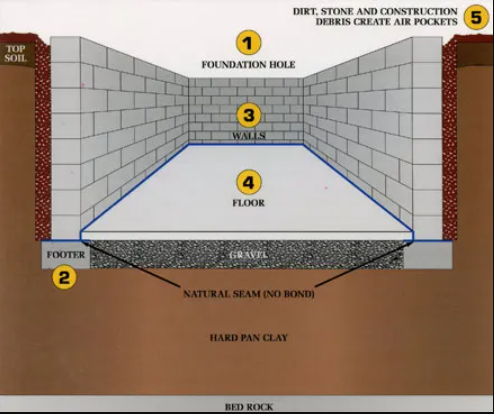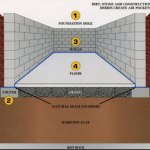Foundation Replacement for Your Home: A Comprehensive Guide
Your home’s foundation is its structural backbone, providing stability and support to the entire structure. However, over time, foundations can deteriorate due to various factors such as age, soil conditions, or structural issues. When the foundation of your home becomes compromised, it can lead to serious structural problems, posing risks to your property’s safety and value. In this comprehensive guide, we will explore the reasons for foundation replacement, the steps involved, the costs, and the importance of hiring professionals for the job.
1. Signs That Your Foundation Needs Replacement
Before delving into the process of foundation replacement, it’s essential to recognize the signs that your foundation needs repair or replacement. Common indicators include:
Cracks: Noticeable cracks in the foundation walls, especially those that are wide, deep, or extending diagonally.
Uneven Floors: If you notice that your floors are no longer level or have begun to slope, it may be a sign of foundation settling.
Wall Bulging or Bowing: If your foundation walls are bulging inward or bowing outward, it’s a clear indication of structural problems.
Water Intrusion: Persistent moisture or water infiltration into the basement or crawl space can cause structural damage to your foundation.
Sticking Doors or Windows: If doors and windows become difficult to open or close, it may be due to shifts in the foundation.
Crumbling or Eroding Concrete: As concrete degrades and erodes, it loses its load-bearing capacity and becomes a concern.
2. Causes of Foundation Damage
Understanding the underlying causes of foundation damage is crucial for addressing the issue effectively. Common factors include:
Soil Conditions: Expansive soils, which expand when wet and contract when dry, can exert pressure on the foundation walls, leading to cracks and shifting.
Poor Drainage: Inadequate or faulty drainage systems can cause water to accumulate around the foundation, leading to soil erosion and foundation damage.
Tree Roots: Large trees planted too close to the house can exert pressure on the foundation as their roots expand and grow.
Settlement: Over time, homes can settle into the ground, causing foundation issues, especially if the settlement is uneven.
Earthquakes: In regions prone to seismic activity, earthquakes can damage foundation structures and necessitate replacement.
3. The Foundation Replacement Process
Foundation replacement is a complex and highly specialized construction project that should be executed by experienced professionals. The process can be broken down into several key steps:
Initial Assessment
The first step is a thorough inspection of the foundation and surrounding area. This includes evaluating the extent of damage, identifying the cause of the problem, and assessing the soil conditions. Professional engineers and contractors may conduct soil tests to determine the appropriate foundation design for the replacement.
Temporary Supports
In most cases, temporary supports or shoring are erected to stabilize the structure during foundation replacement. This step is essential to ensure the safety of the workers and the structure itself.
Excavation
The next step involves excavating the area around the existing foundation, removing the soil, and exposing the old foundation walls. The depth and width of excavation depend on the design of the new foundation and any additional features.
Demolition
Once the foundation is exposed, the old foundation walls are carefully demolished. Special care is taken to prevent damage to the home above. Debris is removed from the site.
Reinforcement and Framing
If the replacement foundation design calls for reinforcement or alterations to the existing structure, such as the addition of support beams or piers, this work is undertaken at this stage.
Forming and Pouring
After reinforcement and framing, a new foundation is formed, often using wooden or metal forms. Concrete is then poured into the forms to create the new foundation walls. The type of concrete used and the curing process depend on the project specifications.
Curing
Curing is a critical step to ensure the strength and integrity of the new foundation. Proper curing typically involves maintaining a moist environment for the concrete to prevent cracking and enhance its strength.
Waterproofing
Before backfilling the foundation, waterproofing materials are applied to the exterior of the foundation walls to prevent water infiltration. This step is essential to protect the new foundation from water-related damage.
Backfilling
With the new foundation walls in place and waterproofed, the excavation site is backfilled with soil. The soil is compacted to ensure proper support and drainage away from the foundation.
Interior Work
Interior work may be necessary to address any damage caused by the foundation replacement. This can include repairing drywall, flooring, and other interior finishes.
Site Restoration
Once the foundation replacement is complete and the interior is restored, the exterior site is restored, including landscaping and any hardscaping features.
Final Inspection
After the project is complete, a final inspection is conducted to ensure that the new foundation is structurally sound and compliant with local building codes and regulations.
4. Costs of Foundation Replacement
Foundation replacement is a significant investment, and the cost can vary widely based on several factors:
Type of Foundation: The type of foundation to be replaced, such as a concrete slab, crawl space, or full basement, will influence the cost.
Foundation Material: The material used for the new foundation, such as poured concrete, block, or other materials, will impact the cost.
Scope of Work: The extent of the damage and the complexity of the replacement process will influence the cost. Full foundation replacement typically costs more than partial replacement or repair.
Soil Conditions: The condition of the soil and any necessary soil stabilization measures can add to the overall cost.
Waterproofing and Drainage: Including waterproofing and proper drainage solutions as part of the replacement project can increase costs but is essential for long-term foundation health.
Labor and Material Costs: Labor and material costs vary by location, so the cost of a foundation replacement can be significantly different depending on where you live.
For a rough estimate, you can expect foundation replacement costs to range from $10,000 to $40,000 or more. It is recommended to obtain multiple quotes from experienced contractors for an accurate assessment of your specific project.
5. The Importance of Professional Foundation Replacement
Foundation replacement is a complex and specialized task that should never be taken lightly or attempted as a DIY project. Here’s why professional expertise is essential:
Safety: Ensuring the safety of your home and the people working on the project is paramount. Professionals have the knowledge and experience to implement safety measures and engineering principles effectively.
Local Codes and Regulations: Building codes and regulations vary by location and may change over time. Professionals are familiar with the latest requirements and will ensure compliance with local authorities.
Soil Analysis: Professionals conduct soil tests to assess the soil’s bearing capacity and determine the most suitable foundation design.
Structural Integrity: Experts can assess the structural integrity of your home and make necessary adjustments to reinforce or modify the structure during the replacement process.
Experience: Professional contractors have experience with a wide range of foundation replacement projects, giving them the knowledge and skills needed to handle unexpected challenges.
Long-Term Warranty: Reputable professionals often offer warranties on their work, giving you peace of mind that your investment is protected.
Foundation replacement is a significant undertaking that requires careful planning, professional expertise, and an understanding of the causes and signs of foundation damage. Ignoring foundation issues can lead to more extensive and costly repairs in the future, along with potential safety risks. If you suspect that your home’s foundation is compromised, it’s crucial to consult with experienced contractors and engineers to assess the situation and determine the best course of action. By investing in a professional foundation replacement, you are safeguarding the structural integrity and long-term value of your home.





